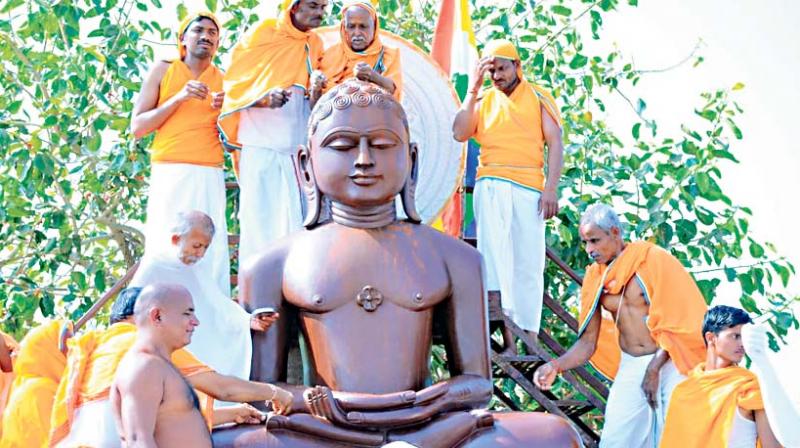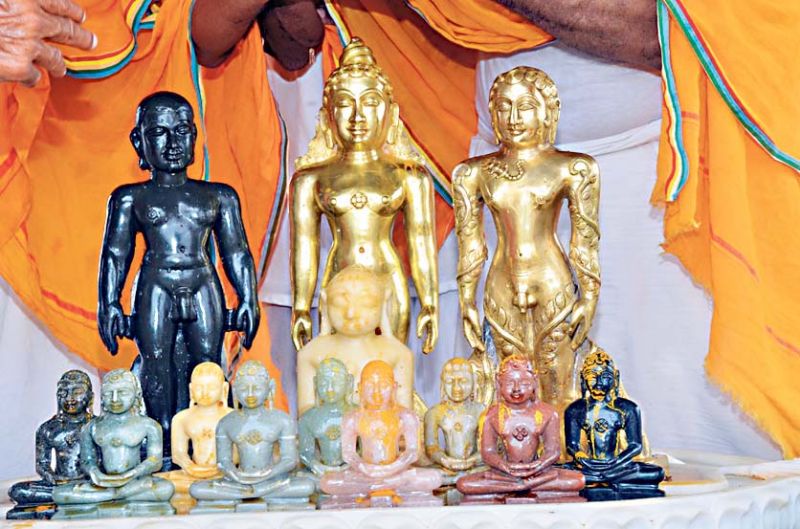In Bhadragiri Betta, a historic find fuels discord
This is no doubt the Jain community's venerated land-they live on the right and left banks of the Krishna which flows through the region.

Statues, inscriptions and other ancient structures are important sources to study and interpret history. These findings help unravel the heritage and traditions of a bygone era and help reinforce the profound respect and awe we have for our ancient generations and the heritage they have left behind for us. But the discovery of some Jinabimba statues in the recent past by a monk in Bhadragiri Betta(hill) in Halingali village of Bagalkot district and his claim that these date back thousands of years, has led to an unseemly controversy between historians and the monk's devotees.
Vittal Shastri explores the roots of the controversy which has cast a shadow on the remarkable history of the place and its fascinating facets and has become more of an ego tussle between the monk and historians.
Not many people had heard of Bhadragiri Betta comprising hillocks spread across fifty-eight acres of land in the tiny hamlet of Halingali six years ago. Part of the newly carved out taluk of Rabakavi-Banahatti in Bagalkot district and a well known centre of Chalukyan architecture, the hillocks had turned into a green paradise over the years with several rare Ayurvedic plants grown here.
Considered a holy place by the Jain community, shrines have sprung up in the hillocks which attract thousands of pilgrims from across the state, neighbouring Maharashtra and other parts of the country. This is no doubt the Jain community’s venerated land-they live on the right and left banks of the Krishna which flows through the region.The head of the pilgrimage centre, Muni Sri Kularatnabhushan has built an attractive water temple on a lake here that resembles the Jal Mandir in Pawapuri of Bihar, dedicated to Lord Mahavira, the founder of Jainism.
Tha Paaduke (sacred footwear) of the 24 Teerthankaras, the water temple and a statue of Mahaveer along with a fountain have come up in the hillock which has become a revered place for the community It is here where the controversy starts with many of the Jain community themselves condemning the monk’s attempts to mislead people with archaeologists too rushing to join the never ending debate.
What triggered this ugly tussle between historians and adherents of a faith which is known for its espousal of renunciation, peace and brotherhood, was the ‘discovery’ of Jinabimba statues in the hills while digging the earth using JCBs. As many as 16 statues were ‘unearthed’ by the temple committee during five excavations in the last 5-6 years on the basis on the monk’s ‘dream’ about the locations of these statues.

The monk cites this unique discovery to justify his claim about the rich Jain history of the place asserting that the hillock was visited by the founder of the Maurya Empire, Chandragupta Maurya and Jain sage Acharya Bhadrabahu nearly 2,300 years ago. He also believes that the hillocks had many mini-gompa (monasteries) as more than seven hundred monks accompanied the Jain sage Bhadrabahu, who had undertaken religious sermons when severe drought struck the region. He was then traveling to the famed Jain pilgrimage centre of Shravanabelagola in Hassan district.
A sculpture with Devanagari inscriptions too has been found in the hill which the monk and his followers, aver, reinforces their claim about the unique Jain connection of the hillocks. They believe that Chandragupta Maurya’s grandson, the great King Ashoka too visited the place to preserve the gompas, which were destroyed by miscreants over the years while searching for treasure.
“Jains were once a thriving community in nearby Jamkhandi and engaged in agriculture on the banks of river Krishna. The traditions of the two major sects- Digambara and Swethambara- started during 300-200 BC, more than 2000 years ago. Therefore, we named the hillock after the monk Bhadrabahu six years ago and tried to develop it into a tourist destination by taking up afforestation. We also want to preserve its history and protect its natural resource as illegal stone quarrying is rampant in the hillock”, reasons the monk, Sri Kularatnabhushan.
This has evoked criticism from some in the community who contend that no monk has supernatural powers and the discovery of the statues are an attempt to mislead people and gain popularity. These developments have made many a historian and archeologist visit the hillock to study how genuine the claims are. “We did research and found megalithic tombs as old as 2,500 years in Halingali village when we visited the site three years ago. But these discoveries are in no way connected with any religious community or the Jains. The Jinabimba statues which the monk claims to have discovered, belong to the 16th century and are not 2,000 or more years old. Fresh soil brought from outside has been deposited beneath these very ancient megalithic sites. I suspect that the statues were deliberately buried in the hills and removed later to divert the attention of the villagers”, contends Dr R.M. Shadaksharaih, retired professor of history and archeology at Kannada Research Institute of Karnataka University.
Meanwhile, the Arsh Marg Seva Sangh,an organisation of the Jain community, which is keen to resolve the row over the discovery of the statues, has written to the government, urging it to investigate the antique statues found by the monk in the hillock. Expressing fear that the ‘discovery’ of the Jinabimba statues could be a hoax to dupe unsuspecting villagers for personal gain, the president of the organisation, Ajit Patil has demanded elaborate digging operations in the hillocks in the presence of Archeological Survey of India(ASI) officials.
“Competent officials or experts should be present at the excavation site to thwart any attempt by mischevious officials to misappropriate priceless historic artefacts. If such artefacts are found, they will have to go to the Digambar Jain Samaj and will help reinforce the antiquity of Jainism. There is also a possibility that these idols were obtained from thieves and smuggled in clandestinely to be buried deep in the earth so that they could be dug out at an appropriate time”, Ajit Patil says.
The situation is no doubt sensitive for any attempt to falsify history could lead to unexpected consequences and even a flare-up between devotees and historians.
Archaeologists have enough tools to distinguish between truth and falsehood and all it needs is a careful and well researched effort to establish if the Jinabimba statues are as old as they are being made out to be. There are religious beliefs and age-old traditions at stake and the government would do well to tread cautiously so that the serene hillocks in Halingali do not become breeding spots of discontent.
Tug of war over land, religion
The Bagalkot district administration stoked the controversy demolishing a Jain temple and other religious structures at Bhadragiri hillock in Halingali claiming they were illegal constructions on government land. This led to protests by the Bhadragiri Committee under the leadership of monk Kularatnabhushan Maharaj. The monk had also undertaken a fast unto death urging the government to restore the demolished structures. Former CM Siddaramaiah had to intervene and interact with the monk to resolve the issue.The officials had even confiscated and examined the 16 idols found by the monk in the hillock with the help of archeology experts and returned them to the Bhadragiri committee saying that they are not 2000 years old as claimed by the monk and hence do not not fall under the purview of the Antiques and Art Treasures Act. The committee has also given an undertaking to the government stating that they will not enter government land till they get the nod. The administration has allotted 2 acres to the committee to undertake preaching and other religious activities in the hillock.

